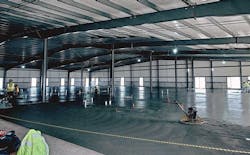Meta Using AI to Create Greener Concrete for its Data Centers
Can the servers inside a data center make the walls and floors greener? That’s the focus of researchers at Meta and the University of Illinois at Urbana-Champaign, who are using artificial intelligence (AI) to reduce the environmental impact of concrete.
The project has created a sustainable concrete mix with greater strength and 40 percent lower carbon emissions, which is being used in some of the construction of Meta’s data center campus in DeKalb, Illinois. The research could have implications for the global construction business, which is seeking ways to reduce the environmental impact of concrete.
A major component of concrete is cement, which requires the use of massive kilns, which require large amounts of energy. The actual chemical process of making cement also emits high levels of CO2. As a result, the cement in concrete accounts for approximately 8 percent of carbon emissions globally.
Concrete is a complex mixture of many ingredients. The Meta-UIUC research sought to reduce the carbon footprint of concrete by reducing the amount of cement and replacing it with other materials like fly ash, slag, and ground glass, all of which have a lower carbon intensity than cement.
The research team sought to use AI to accelerate the evaluation of different concrete formulations, using experts from UIC, along with a university database that captured characteristics of more than 1,000 different mixtures of concrete.
The researchers worked with Meta’s concrete trade partner, Ozinga, to test and refine their formulations. Test applications were poured in non-critical areas of the DeKalb Data Center, and Meta says the concrete that meets its long-term strength requirements and has a 40 percent lower carbon impact than the regional benchmark.
“While Meta is encouraged by the success of this pilot, further developments and tests are needed to scale the impact of this innovation,” Meta engineers Julius Kusuma and Amruta Sudhalkar said in a blog post outlining the research. “Depending on material availability, there is significant potential for the general building industry to adopt the use of concrete mixes similar to the ones tested in our DeKalb data center, particularly for construction projects that aren’t subject to compressed construction schedules.”
A Broad Effort to Create Greener Concrete
The Facebook project is part of a broader search for greener concrete. The potential environmental benefits are huge.
Concrete is the most widely-used man-made material on the planet, and second only to water as the most consumer resource. Its durability and strength make it ideal for building things that last. It is the leading component of bridges, dams, parking garages, and plays a huge role in the construction of data centers and other industrial buildings.
The carbon problems with cement are well known in construction, including the data center industry. But large users are cautious in making major changes in materials, given the downside of structural failures.
We’ve previously written about the use of CarbonCure Technology in data centers. CarbonCure also works to alter the mix of concrete to produce fewer emissions, and has been adopted by Compass Datacenters and others. CarbonCure’s investors include Breakthrough Energy Ventures, a large investment fund backed by Bill Gates, along with Amazon’s Climate Pledge Fund and Microsoft. Other companies offering low-carbon concrete products, including Solidia and bioMASON.
The Meta/UIUC research may add to those candidates, but additional research and testing is needed.
Harnessing AI to Speed Analysis
The team from Meta and UIUC sought to speed and refine the process by using computing power and AI to identify promising formulations. “Manually optimizing a concrete formula for both sustainable and technically sound outcomes for different end uses is a formidable challenge, one that can be time-intensive,” the Meta team said.
Researchers vet a database of concrete formulas and performance characteristics. (Image: Meta)
Meta teamed with two UIUC experts, AI expert Prof. Lav Varshney from the electrical and computer engineering department, and concrete expert Prof. Nishant Garg from the civil engineering department. Varshney and Garg trained a model using the Concrete Compressive Strength data set, an openly available database from the UCI Machine Learning Repository, which has detailed analyses of 1,030 instances of concrete formulas and their attributes.
The low-carbon concrete formulas generated by the model enabled significant replacement of cement (upwards of 50 percent) with a combination of two types of low-carbon substitutes, fly ash and slag.
“In the absence of AI resources, discovering similarly good, sustainable formulas that also meet technical performance criteria could require several time-intensive iterations,” Meta said. “With AI, we were able to accelerate the discovery process and validate good formulas within weeks.”
After the final formula was tested in Ozinga’s labs, the formulation was used on multiple “non-critical” structures at Meta’s DeKalb data center, including the floor slabs for the guardhouse and construction management team.
The field tests confirmed that the resulting low-emission concrete formula exceeded the seven-day and 28-day strength requirements, with a carbon impact 40 percent lower than the regional benchmark.
However, to see broader use, the new low-carbon concrete mix will need to set more quickly.
The compressive strength of the refined AI-generated formulas is tested. (Photo: Meta)
“We are working to improve the early strength performance of the concrete at the three- to five–day marks, and account for the impact that variations in environmental conditions, such as temperature and wind, can have on concrete performance,” the Meta team reported.
The Meta team hinted at other initiatives to rethink data center construction.
“Our exploration of innovative solutions to reduce data center construction emissions is not limited to concrete,” they wrote. “There are opportunities to reduce the emissions of other materials. We are also exploring innovative data center designs as another way to improve sustainability.”
The research has gained the attention of the broader AI community, as it was featured this week on the widely-read Import AI newsletter.
“This an example of how humans and AI systems can work together to create something greater than the sum of its parts,” wrote Jack Clark, the editor of Import AI.
About the Author





